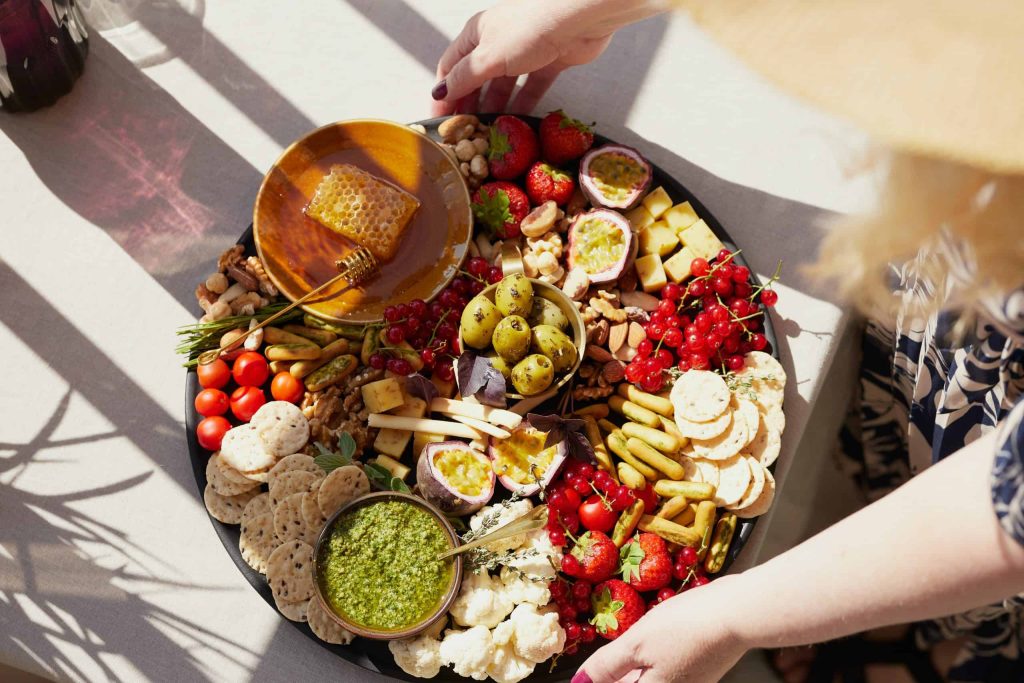Exploring the Art of Charcuterie Boards: A Feast for the Senses

In the realm of culinary delights, few creations offer as much visual appeal, flavor variety, and sheer elegance as the charcuterie board. Originating from the French tradition of serving cured meats, cheeses, fruits, and accompaniments on wooden platters, charcuterie boards have evolved into a sophisticated art form appreciated by food enthusiasts worldwide. Let’s delve into the intricacies of crafting these exquisite spreads.
The Anatomy of a Charcuterie Board
A well-curated charcuterie board is a symphony of flavors and textures, carefully arranged to tantalize the palate. Here’s what you’ll typically find adorning these boards:
Cured Meats:
At the heart of any charcuterie board lies an assortment of meticulously cured meats. From savory prosciutto and spicy chorizo to smoky salami and delicate pâté, each selection offers a unique taste experience.
Artisanal Cheeses:
Complementing the meats are an array of artisanal cheeses, ranging from creamy brie and tangy blue cheese to aged cheddar and nutty Gouda. The interplay of flavors between the meats and cheeses is a cornerstone of charcuterie board mastery.
Accompaniments:
To elevate the flavor profile, charcuterie boards often feature an assortment of accompaniments such as olives, pickles, nuts, and honey. These additions provide contrast and balance, enhancing the overall tasting experience.
Breads and Crackers:
Serving as the vessel for enjoying the meats and cheeses, an assortment of crusty bread, crackers, and crostini rounds out the ensemble. Their crunchy texture and neutral flavor serve as the perfect canvas for the other components.
Garnishes:
The final touch comes in the form of fresh herbs, edible flowers, and dried fruits, adding a pop of color and visual appeal to the board. These garnishes not only enhance the presentation but also contribute subtle hints of aroma and flavor.
Crafting the Perfect Charcuterie Board
Creating a visually stunning and delectable charcuterie board is as much an art as it is a culinary endeavor. Here are some tips for mastering the craft:
- Quality Ingredients: Start with high-quality meats and cheeses sourced from reputable vendors or local artisans. Opt for a diverse selection to cater to different tastes and preferences.
- Balance and Variety: Aim for a balanced assortment of flavors, textures, and colors. Mix and match salty, savory, sweet, and tangy components to keep the palate intrigued.
- Presentation: Pay attention to the visual presentation of the board, arranging the ingredients in an aesthetically pleasing manner. Play with symmetry, contrast, and negative space to create visual interest.
- Temperature and Texture: Consider the temperature and texture of each component. Serve meats and cheeses at room temperature to enhance their flavors, and vary the textures to provide a dynamic tasting experience.
- Customization: Tailor the charcuterie board to suit the occasion and preferences of your guests. Experiment with different combinations of meats, cheeses, and accompaniments to create unique flavor profiles.
The Social Experience of Charcuterie
Beyond its culinary appeal, the charcuterie board embodies the spirit of conviviality and sharing. Whether enjoyed at intimate gatherings, wine tastings, or festive celebrations, it serves as a focal point for social interaction and culinary exploration. The act of assembling and enjoying a charcuterie board encourages conversation, camaraderie, and the appreciation of fine food and company.
Conclusion
In a world where culinary experiences are increasingly valued for their sensory richness and cultural significance, the charcuterie board stands out as a timeless indulgence. With its exquisite presentation, diverse flavors, and social allure, it continues to captivate and delight gastronomes around the globe. So next time you gather with friends or family, consider crafting a charcuterie board and embark on a journey of gastronomic delight.







